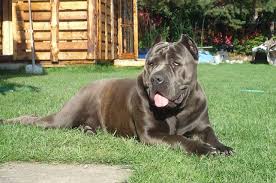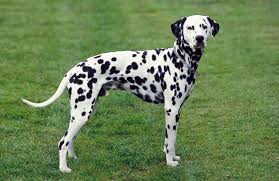Bandogs: Description and Complete Care Guide
The Bandog, also known as the Bandogge, is a remarkable and formidable breed of dog that combines strength, loyalty, and intelligence. With a history rooted in ancient times, the Bandog has been selectively bred for centuries to be the ultimate guardian and protector. In this article, we will delve into the origins, characteristics, and temperament of the Bandog, as well as its suitability as a family pet and working companion.
The origins of the Bandog can be traced back to ancient civilizations, where they were often employed as war dogs and protectors of estates. The term “Bandog” itself refers to a dog that was bound or chained, highlighting their role as fierce guard dogs.
The breed’s lineage includes various mastiff-type dogs and large working breeds, such as the English Mastiff, American Pit Bull Terrier, and Bullmastiff. These careful crosses aimed to enhance the Bandog’s strength, loyalty, and protective instincts.
Bandogs are large and muscular dogs with an imposing presence. They have a well-defined, athletic build, giving them both power and agility. The breed typically exhibits a broad head, strong jaws, and a thick neck. Their coat can vary in length and texture, depending on the specific lineage, but it is usually short and dense.
When it comes to temperament, Bandogs are known for their unwavering loyalty and protective nature. They form strong bonds with their families and are incredibly devoted and affectionate towards them. However, their protective instincts are highly developed, making them cautious and reserved around strangers. Bandogs require proper socialization from an early age to ensure they differentiate between genuine threats and harmless situations.
Training a Bandog requires an experienced and assertive handler who can establish themselves as the pack leader. Early socialization and obedience training are essential to channel their protective instincts in a controlled manner. Bandogs are intelligent dogs and are known to respond well to positive reinforcement techniques.
They require regular exercise to keep them physically and mentally stimulated. Long walks, vigorous play sessions, and structured training sessions are necessary to prevent boredom and maintain their overall well-being.
Bandogs can make excellent family pets under the right circumstances. They are fiercely loyal and protective of their families, including children. However, due to their size and protective nature, they may not be suitable for first-time dog owners or families with small children who may inadvertently provoke or mishandle them. Responsible ownership includes providing proper socialization, training, and ensuring the Bandog receives the mental and physical stimulation it needs.
Bandogs excel in various working roles, such as personal protection dogs, estate guardians, and search and rescue dogs. Their natural instincts, combined with their strength and courage, make them well-suited for these tasks. Proper training, in collaboration with professional trainers, is essential to refine their skills and ensure they can perform their duties effectively.
The Bandog is a remarkable breed with a rich history and exceptional qualities. Their strength, loyalty, and protective nature make them highly suitable as working dogs and formidable guardians. While they can make loving family pets, their size and protective instincts require responsible ownership and proper training. With the right guidance, the Bandog can be a cherished companion and an unwavering protector for those fortunate enough to have them in their lives.
History and Origin of Bandogs

The history and origin of the Bandog can be traced back to ancient times, where they were specifically bred for their strength, loyalty, and protective instincts. The term “Bandog” itself refers to a dog that was bound or chained, highlighting their role as powerful guard dogs.
The exact origins of the Bandog are not well-documented, as the breed’s development was often carried out by dedicated breeders who focused on creating the ultimate guardian. The breeding programs for Bandogs typically involved crossing various mastiff-type dogs and large working breeds.
One of the key ancestors of the Bandog is the English Mastiff, a massive and powerful breed that dates back thousands of years. The English Mastiff was originally used as a war dog and protector of estates, and its size, strength, and loyalty were highly valued. By crossing the English Mastiff with other breeds, such as the Bullmastiff and American Pit Bull Terrier, breeders aimed to enhance specific traits while maintaining the overall strength and protective instincts of the Bandog.
The American Pit Bull Terrier, known for its tenacity, agility, and gameness, also played a role in the development of the Bandog. The Pit Bull Terrier’s athleticism and determination were sought after to create a breed that was not only strong and protective but also capable of performing various tasks.
The Bullmastiff, a breed developed in the 19th century by crossing the Mastiff with the Bulldog, also contributed to the Bandog’s lineage. The Bullmastiff was bred to be a dedicated gamekeeper’s dog, used to catch and immobilize intruders on large estates. Their mix of strength, speed, and endurance made them well-suited for this purpose.
Through careful breeding and selection, breeders aimed to create a dog that possessed the strength and power of the mastiff-type breeds, the tenacity and agility of the Pit Bull Terrier, and the endurance and guarding instincts of the Bullmastiff. The result was the Bandog, a versatile and formidable breed with exceptional protective qualities.
It is important to note that the Bandog is not a recognized breed by major kennel clubs, such as the American Kennel Club (AKC) or the Kennel Club (UK). However, they are recognized and valued by enthusiasts and working dog communities for their unique attributes and capabilities.
Overall, the history and origin of the Bandog are rooted in the desire to create a loyal and powerful guardian. Although the exact lineage and specific breeding programs may vary, the Bandog’s legacy as a dedicated protector remains strong, and they continue to be valued for their impressive qualities in various working roles.
Read Also: Brooding Methods in Raising Poultry Chickens for Optimum Performance
Health Issues and Lifespan of Bandogs

Like any other breed of dog, the Bandog is susceptible to certain health issues. However, it’s important to note that the health of an individual dog can vary based on genetics, breeding practices, and overall care provided by the owner. Responsible breeders prioritize the health and well-being of their dogs and take steps to minimize the occurrence of genetic health problems.
Some potential health issues that can be associated with the Bandog breed include:
Hip and Elbow Dysplasia: These are developmental conditions that affect the hip and elbow joints, causing pain, lameness, and reduced mobility. Proper screening and breeding practices can help reduce the incidence of these conditions.
Bloat (Gastric Dilatation-Volvulus): Bloat is a potentially life-threatening condition that occurs when a dog’s stomach fills with gas and twists upon itself. It requires immediate veterinary attention and can be prevented by feeding smaller, more frequent meals and avoiding vigorous exercise before and after meals.
Allergies: Bandogs, like many other breeds, can be prone to allergies, which may manifest as skin irritations, itching, or gastrointestinal issues. Identifying and managing the specific allergens can help alleviate symptoms.
Eye Issues: Certain eye conditions, such as entropion (inward rolling of the eyelid) and ectropion (outward rolling of the eyelid), may occur in Bandogs. Regular eye examinations by a veterinarian can help detect and manage these conditions.
Heart Conditions: Some Bandogs may be predisposed to certain heart conditions, such as dilated cardiomyopathy (enlarged heart) or aortic stenosis (narrowing of the aortic valve). Regular cardiac evaluations can help identify and manage these conditions.
It’s important for potential owners to research reputable breeders who prioritize the health and genetic screening of their dogs. A responsible breeder will conduct appropriate health tests on their breeding dogs to reduce the likelihood of passing on hereditary health issues to their offspring.
The lifespan of a Bandog is typically around 10 to 12 years. However, individual factors such as genetics, diet, exercise, and overall healthcare can influence a dog’s lifespan. Providing proper nutrition, regular veterinary care, exercise, and a loving environment can contribute to a longer and healthier life for a Bandog.
It’s worth noting that the Bandog’s lifespan is an estimate based on general observations, and some individuals may live longer or shorter lives depending on various factors.
As with any dog, it’s important for Bandog owners to prioritize routine veterinary care, provide a balanced diet, maintain a healthy weight, and ensure their dogs receive regular exercise and mental stimulation to promote overall well-being and longevity.
Read Also: General Field Activities and Operations in Crop Production
Bandogs Complete Grooming and Care Guide

The Bandog is a powerful and intelligent breed known for its guarding and protection instincts. Proper grooming and care are essential to keep your Bandog healthy, comfortable, and looking their best. Here’s a complete grooming and care guide for your Bandog:
Coat Care:
Brushing: Bandogs have short coats that are relatively low maintenance. Brush their coat once a week using a rubber curry brush or a bristle brush to remove loose hair and keep the coat clean.
Bathing: Bathe your Bandog as needed, usually every 2-3 months or when they get dirty. Use a dog-specific shampoo and conditioner to maintain their skin and coat health. Avoid over-bathing, as it can strip the natural oils from their skin.
Nail Trimming: Regularly check and trim your Bandog’s nails to prevent them from becoming too long or causing discomfort. Use a dog nail trimmer or consider seeking professional help if you’re not confident in doing it yourself.
Ear Cleaning: Inspect your Bandog’s ears regularly for any signs of infection, wax buildup, or redness. Clean their ears gently using a damp cotton ball or a dog-specific ear cleaner to prevent infections.
Dental Care:
Brushing: Brush your Bandog’s teeth at least 2-3 times a week using a dog-specific toothbrush and toothpaste. Regular brushing helps prevent plaque buildup, gum disease, and bad breath.
Dental Chews: Provide dental chews or appropriate chew toys to help keep your Bandog’s teeth clean and strong. These can help reduce tartar and plaque buildup.
Exercise and Mental Stimulation:
Bandogs are active dogs that require regular exercise to stay healthy and happy. Provide daily walks, play sessions, and engage them in interactive games to keep them physically and mentally stimulated.
Mental Stimulation: Use puzzle toys, obedience training, and tasks that require problem-solving to engage your Bandog’s mind. This breed thrives on having a job to do, so consider activities like obedience training or agility.
Health Care:
Veterinary Visits: Schedule regular check-ups with a veterinarian to ensure your Bandog’s overall health and to keep up with vaccinations, parasite prevention, and any necessary medical treatments.
Vaccinations: Follow your veterinarian’s recommended vaccination schedule to protect your Bandog from common canine diseases.
Parasite Control: Administer flea, tick, and heartworm preventives as prescribed by your vet to keep your Bandog protected from external and internal parasites.
Spaying/Neutering: Discuss with your veterinarian the appropriate time to spay or neuter your Bandog, considering factors such as age, overall health, and breed-specific recommendations.
Nutrition: Feed your Bandog a balanced and high-quality dog food appropriate for their age, size, and activity level. Consult with your veterinarian to determine the right portion sizes and feeding schedule for your dog.
Provide fresh water at all times and ensure that the water bowl is clean and refilled regularly.
Socialization and Training: Bandogs require early socialization to ensure they grow up to be well-adjusted and friendly dogs. Introduce them to different people, animals, and environments gradually and positively.
Obedience Training: Enroll your Bandog in obedience classes or work on training at home to establish good behavior, manners, and a strong bond between you and your dog.
Remember, every dog is unique, and individual care needs may vary. Regular grooming sessions, proper nutrition, exercise, and lots of love and attention will contribute to a happy and healthy Bandog.
Read Also: Products That Can Be Derived From Kitchen Wastes









